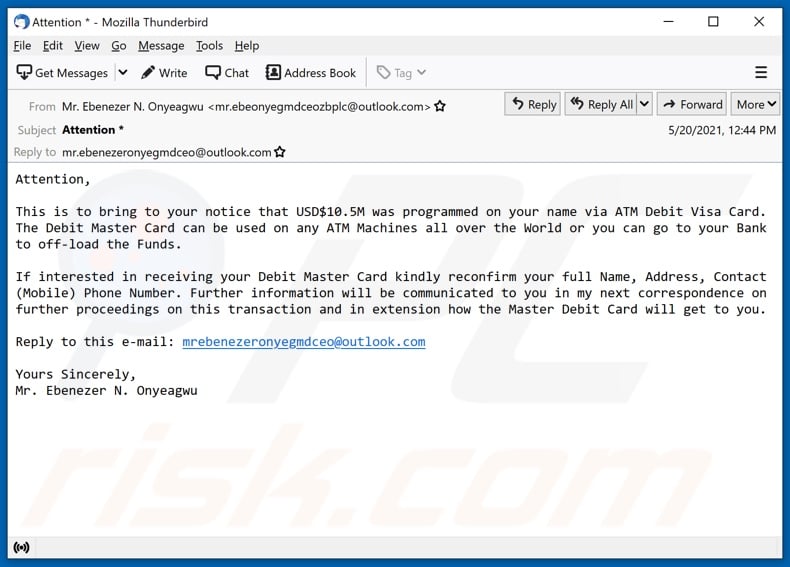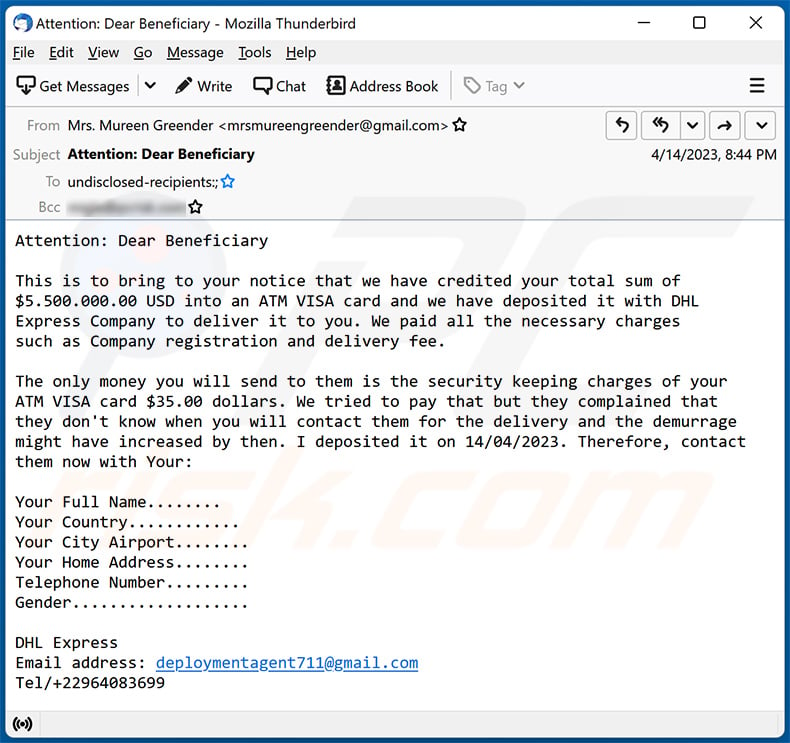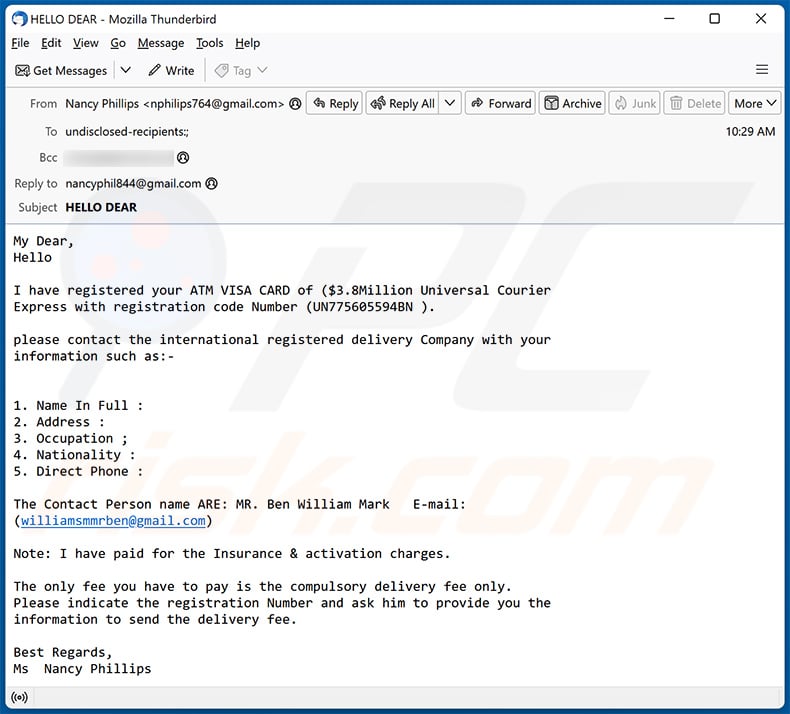Get free scan and check if your device is infected.
Remove it nowTo use full-featured product, you have to purchase a license for Combo Cleaner. Seven days free trial available. Combo Cleaner is owned and operated by RCS LT, the parent company of PCRisk.com.
What is the "Debit Card" scam email?
"Debit Card email scam" refers to a large-scale operation during which deceptive emails are sent by the thousand. The letters distributed through this campaign claim that recipients have a debit card programmed on their name.
This fake card supposedly contains a ludicrous sum. It must be emphasized that all of the claims made by these scam emails - are false, and they are in no way associated with Mastercard or VISA Incorporated.
The aim of this spam campaign is to gain and abuse recipients' trust for financial gain.

"Debit Card" email scam overview
The "Debit Card" scam letters (subject/title "Attention * "; may vary) state that the recipients have an "ATM Debit Visa Card" with 10.5 million US dollars on it. The deceptive emails then refer to the fake card as a "Debit Master Card", and state that it can be used on ATMs worldwide.
Alternatively, the nonexistent funds can be withdrawn from the recipients' banks. The letters instruct recipients to reconfirm their full names, addresses, and (mobile) phone numbers - to receive the debit card.
More information on the proceedings and transactions will be allegedly communicated in further correspondence. As mentioned in the introduction, the "Debit Card" emails are scams, and they cannot be trusted.
Regardless of what actions the recipients take, they will not receive the promised funds. The "Debit Card" deceptive emails operate as phishing scams targeting personal information.
Scammers monetize the collected data by selling it to third-parties and/or using it to further personalized schemes. Since the letters in question urge recipients to continue communication, it is likely that the "Debit Card" scam has multiple stages.
Schemes of this type can have various different modus operandi. They can target other information (possibly, such data that requires an elevated level of trust for victims to disclose), e.g., account log-in credentials (i.e., IDs, email addresses, usernames, passwords), banking account details, credit card numbers, and so on.
Furthermore, even when scammers use scenarios where victims are promised financial rewards - they are still asked to make certain payments. For example, scammers may request shipping, registration, subscription, verification, transaction, storage, and other fake fees to be paid.
To summarize, by trusting the "Debit Card" scam emails, users can experience severe privacy issues, significant financial losses, and identity theft.
| Name | Debit Card Email Scam |
| Threat Type | Phishing, Scam, Social Engineering, Fraud |
| Fake Claim | Scam emails claim recipients have a debit card, containing a huge sum of money, programmed on their name. |
| Symptoms | Unauthorized online purchases, changed online account passwords, identity theft, illegal access of the computer. |
| Distribution methods | Deceptive emails, rogue online pop-up ads, search engine poisoning techniques, misspelled domains. |
| Damage | Loss of sensitive private information, monetary loss, identity theft. |
| Malware Removal (Windows) |
To eliminate possible malware infections, scan your computer with legitimate antivirus software. Our security researchers recommend using Combo Cleaner. Download Combo CleanerTo use full-featured product, you have to purchase a license for Combo Cleaner. 7 days free trial available. Combo Cleaner is owned and operated by RCS LT, the parent company of PCRisk.com. |
Phishing spam campaign examples
"Chase Account Has Been Locked", "DHL Package Tracking Confirmation", "EuroLine Windows Exchange", and "Rabobank email scam" are some examples of phishing spam campaigns. Information-targeting scams target a wide variety of data.
Deceptive emails are not used exclusively for phishing and other scams, they are also employed to proliferate malware (e.g., trojans, ransomware, cryptominers, etc.). Due to how widespread spam mail is, it is strongly recommended to exercise caution with incoming emails.
How do spam campaigns infect computers?
Malware is proliferated via virulent files distributed through spam campaigns. The infectious files can be attached to and/or linked inside the scam emails.
These files can be in various formats, e.g., Microsoft Office and PDF documents, archives (RAR, ZIP, etc.), executables (.exe, .run, etc.), JavaScript, and so forth. When the files are executed, run, or otherwise opened - the infection chain (i.e., download/installation of malicious programs) is initiated.
For example, Microsoft Office documents infect systems by executing malicious macro commands. This process begins the moment a document is opened in Microsoft Office versions released before 2010.
Later versions have "Protected View" mode that prevents automatic execution of macros. Instead, users are asked to enable macro commands (i.e., editing/content), and they are warned about the potential risks.
How to avoid installation of malware?
To avoid infecting the system via spam mail, it is advised against opening dubious and irrelevant emails - especially any attachments or links found in them. It is recommended to use Microsoft Office versions released after 2010.
Aside from spam campaigns, malware is also spread through untrustworthy download sources (e.g., unofficial and free file-hosting sites, Peer-to-Peer sharing networks, and other third-party downloaders), illegal activation tools ("cracks"), and fake updates.
Hence, it is crucial to only use official and verified download channels. Additionally, all programs must be activated and updated with functions/tools provided by genuine developers. To protect device and user safety, it is paramount to have a reputable anti-virus/anti-spyware suite installed and kept up-to-date.
Furthermore, this software has to be used to perform regular system scans and remove detected threats and issues. If you've already opened malicious attachments, we recommend running a scan with Combo Cleaner Antivirus for Windows to automatically eliminate infiltrated malware.
Text presented in the "Debit Card" scam email letter:
Subject: Attention *
Attention,
This is to bring to your notice that USD$10.5M was programmed on your name via ATM Debit Visa Card. The Debit Master Card can be used on any ATM Machines all over the World or you can go to your Bank to off-load the Funds.
If interested in receiving your Debit Master Card kindly reconfirm your full Name, Address, Contact (Mobile) Phone Number. Further information will be communicated to you in my next correspondence on further proceedings on this transaction and in extension how the Master Debit Card will get to you.
Reply to this e-mail: mrebenezeronyegmdceo@outlook.com
Yours Sincerely,
Mr. Ebenezer N. Onyeagwu
Another example of Debit Card-themed spam email:

Text presented within:
Subject: Attention: Dear Beneficiary
Attention: Dear Beneficiary
This is to bring to your notice that we have credited your total sum of
$5.500.000.00 USD into an ATM VISA card and we have deposited it with DHL
Express Company to deliver it to you. We paid all the necessary charges
such as Company registration and delivery fee.The only money you will send to them is the security keeping charges of your
ATM VISA card $35.00 dollars. We tried to pay that but they complained that
they don't know when you will contact them for the delivery and the demurrage
might have increased by then. I deposited it on 14/04/2023. Therefore, contact
them now with Your:Your Full Name........
Your Country............
Your City Airport........
Your Home Address........
Telephone Number.........
Gender...................DHL Express
Email address: deploymentagent711@gmail.com
Tel/+22964083699
Yet another example of an email from a debit card-themed spam campaign:

Text presented within:
Subject: HELLO DEAR
My Dear,
HelloI have registered your ATM VISA CARD of ($3.8Million Universal Courier
Express with registration code Number (UN775605594BN ).please contact the international registered delivery Company with your
information such as:-
1. Name In Full :
2. Address :
3. Occupation ;
4. Nationality :
5. Direct Phone :The Contact Person name ARE: MR. Ben William Mark E-mail:
(williamsmmrben@gmail.com)Note: I have paid for the Insurance & activation charges.
The only fee you have to pay is the compulsory delivery fee only.
Please indicate the registration Number and ask him to provide you the
information to send the delivery fee.Best Regards,
Ms Nancy Phillips
Instant automatic malware removal:
Manual threat removal might be a lengthy and complicated process that requires advanced IT skills. Combo Cleaner is a professional automatic malware removal tool that is recommended to get rid of malware. Download it by clicking the button below:
DOWNLOAD Combo CleanerBy downloading any software listed on this website you agree to our Privacy Policy and Terms of Use. To use full-featured product, you have to purchase a license for Combo Cleaner. 7 days free trial available. Combo Cleaner is owned and operated by RCS LT, the parent company of PCRisk.com.
Quick menu:
- What is Debit Card spam?
- Types of malicious emails.
- How to spot a malicious email?
- What to do if you fell for an email scam?
Types of malicious emails:
![]() Phishing Emails
Phishing Emails
Most commonly, cybercriminals use deceptive emails to trick Internet users into giving away their sensitive private information, for example, login information for various online services, email accounts, or online banking information.
Such attacks are called phishing. In a phishing attack, cybercriminals usually send an email message with some popular service logo (for example, Microsoft, DHL, Amazon, Netflix), create urgency (wrong shipping address, expired password, etc.), and place a link which they hope their potential victims will click on.
After clicking the link presented in such email message, victims are redirected to a fake website that looks identical or extremely similar to the original one. Victims are then asked to enter their password, credit card details, or some other information that gets stolen by cybercriminals.
![]() Emails with Malicious Attachments
Emails with Malicious Attachments
Another popular attack vector is email spam with malicious attachments that infect users' computers with malware. Malicious attachments usually carry trojans that are capable of stealing passwords, banking information, and other sensitive information.
In such attacks, cybercriminals' main goal is to trick their potential victims into opening an infected email attachment. To achieve this goal, email messages usually talk about recently received invoices, faxes, or voice messages.
If a potential victim falls for the lure and opens the attachment, their computers get infected, and cybercriminals can collect a lot of sensitive information.
While it's a more complicated method to steal personal information (spam filters and antivirus programs usually detect such attempts), if successful, cybercriminals can get a much wider array of data and can collect information for a long period of time.
![]() Sextortion Emails
Sextortion Emails
This is a type of phishing. In this case, users receive an email claiming that a cybercriminal could access the webcam of the potential victim and has a video recording of one's masturbation.
To get rid of the video, victims are asked to pay a ransom (usually using Bitcoin or another cryptocurrency). Nevertheless, all of these claims are false - users who receive such emails should ignore and delete them.
How to spot a malicious email?
While cyber criminals try to make their lure emails look trustworthy, here are some things that you should look for when trying to spot a phishing email:
- Check the sender's ("from") email address: Hover your mouse over the "from" address and check if it's legitimate. For example, if you received an email from Microsoft, be sure to check if the email address is @microsoft.com and not something suspicious like @m1crosoft.com, @microsfot.com, @account-security-noreply.com, etc.
- Check for generic greetings: If the greeting in the email is "Dear user", "Dear @youremail.com", "Dear valued customer", this should raise suspiciousness. Most commonly, companies call you by your name. Lack of this information could signal a phishing attempt.
- Check the links in the email: Hover your mouse over the link presented in the email, if the link that appears seems suspicious, don't click it. For example, if you received an email from Microsoft and the link in the email shows that it will go to firebasestorage.googleapis.com/v0... you shouldn't trust it. It's best not to click any links in the emails but to visit the company website that sent you the email in the first place.
- Don't blindly trust email attachments: Most commonly, legitimate companies will ask you to log in to their website and to view any documents there; if you received an email with an attachment, it's a good idea to scan it with an antivirus application. Infected email attachments are a common attack vector used by cybercriminals.
To minimise the risk of opening phishing and malicious emails we recommend using Combo Cleaner Antivirus for Windows.
Example of a spam email:

What to do if you fell for an email scam?
- If you clicked on a link in a phishing email and entered your password - be sure to change your password as soon as possible. Usually, cybercriminals collect stolen credentials and then sell them to other groups that use them for malicious purposes. If you change your password in a timely manner, there's a chance that criminals won't have enough time to do any damage.
- If you entered your credit card information - contact your bank as soon as possible and explain the situation. There's a good chance that you will need to cancel your compromised credit card and get a new one.
- If you see any signs of identity theft - you should immediately contact the Federal Trade Commission. This institution will collect information about your situation and create a personal recovery plan.
- If you opened a malicious attachment - your computer is probably infected, you should scan it with a reputable antivirus application. For this purpose, we recommend using Combo Cleaner Antivirus for Windows.
- Help other Internet users - report phishing emails to Anti-Phishing Working Group, FBI’s Internet Crime Complaint Center, National Fraud Information Center and U.S. Department of Justice.
Frequently Asked Questions (FAQ)
Why did I receive this email?
Spam emails are not personal. This mail is distributed in mass-scale campaigns – hence, thousands of users receive identical messages.
I have provided my personal information when tricked by this spam email, what should I do?
If you have provided your personally-identifiable or finance-related information (e.g., ID card details, credit card numbers, etc.) – immediately contact the appropriate authorities. And if you've disclosed your log-in credentials – change the passwords of all potentially compromised accounts and inform their official support without delay.
I have read a spam email but didn't open the attachment, is my computer infected?
No, opening an email will not result in a system infection. Malware download/installation processes are triggered when malicious attachments or links are opened/clicked.
I have downloaded and opened a file attached to a spam email, is my computer infected?
If the opened file was an executable (.exe, .run, etc.) – most likely, yes – your device has been infected. However, document formats (.doc, .xls, .pdf, .one, etc.) may need additional user interaction (e.g., enabling macro commands, clicking on embedded content, etc.) to start downloading/installing malware.
Will Combo Cleaner remove malware infections present in email attachments?
Yes, Combo Cleaner is capable of detecting and eliminating most of the known malware infections. It must be stressed that since sophisticated malicious software usually hides deep within systems – running a full system scan is essential.
Share:

Tomas Meskauskas
Expert security researcher, professional malware analyst
I am passionate about computer security and technology. I have an experience of over 10 years working in various companies related to computer technical issue solving and Internet security. I have been working as an author and editor for pcrisk.com since 2010. Follow me on Twitter and LinkedIn to stay informed about the latest online security threats.
PCrisk security portal is brought by a company RCS LT.
Joined forces of security researchers help educate computer users about the latest online security threats. More information about the company RCS LT.
Our malware removal guides are free. However, if you want to support us you can send us a donation.
DonatePCrisk security portal is brought by a company RCS LT.
Joined forces of security researchers help educate computer users about the latest online security threats. More information about the company RCS LT.
Our malware removal guides are free. However, if you want to support us you can send us a donation.
Donate
▼ Show Discussion